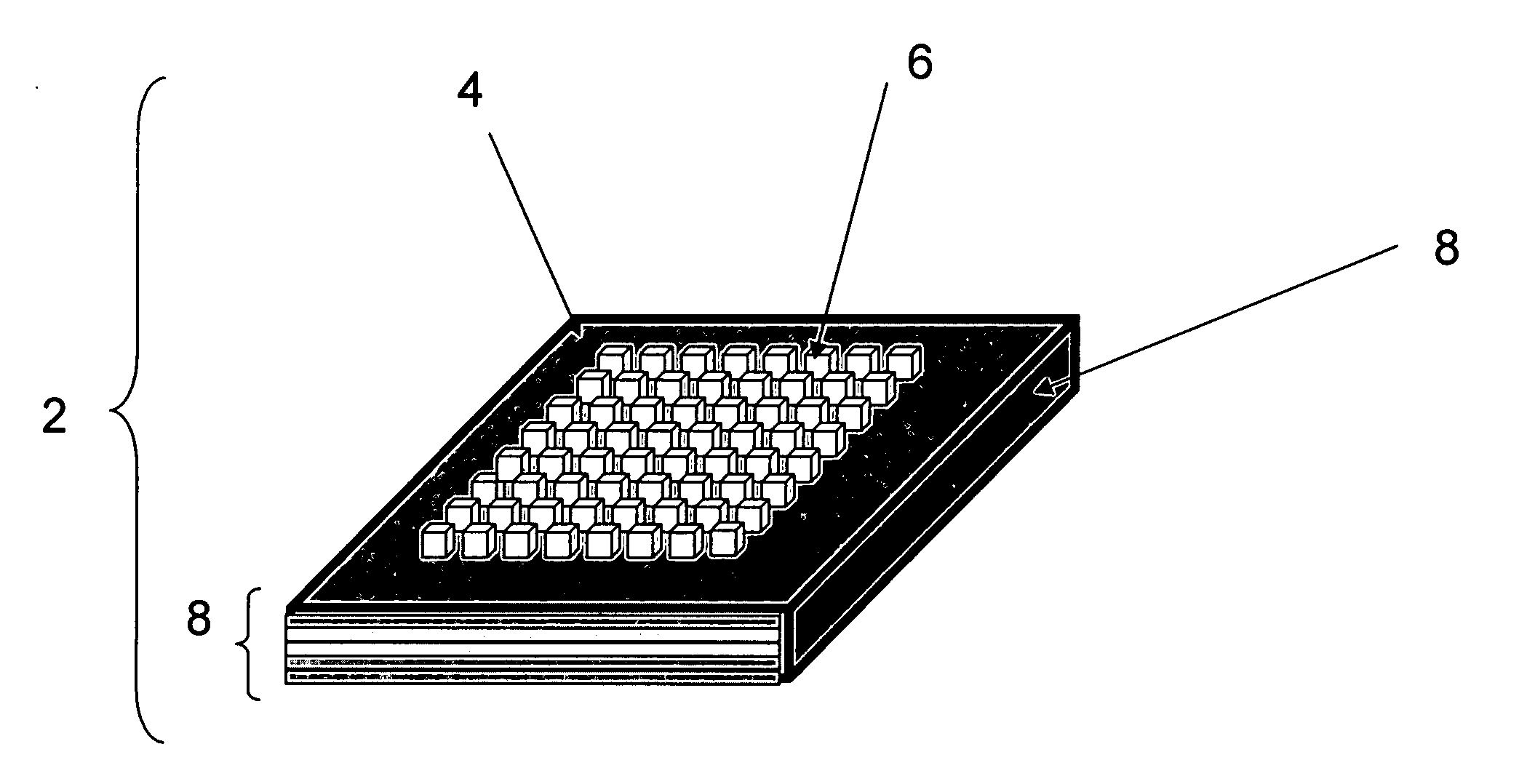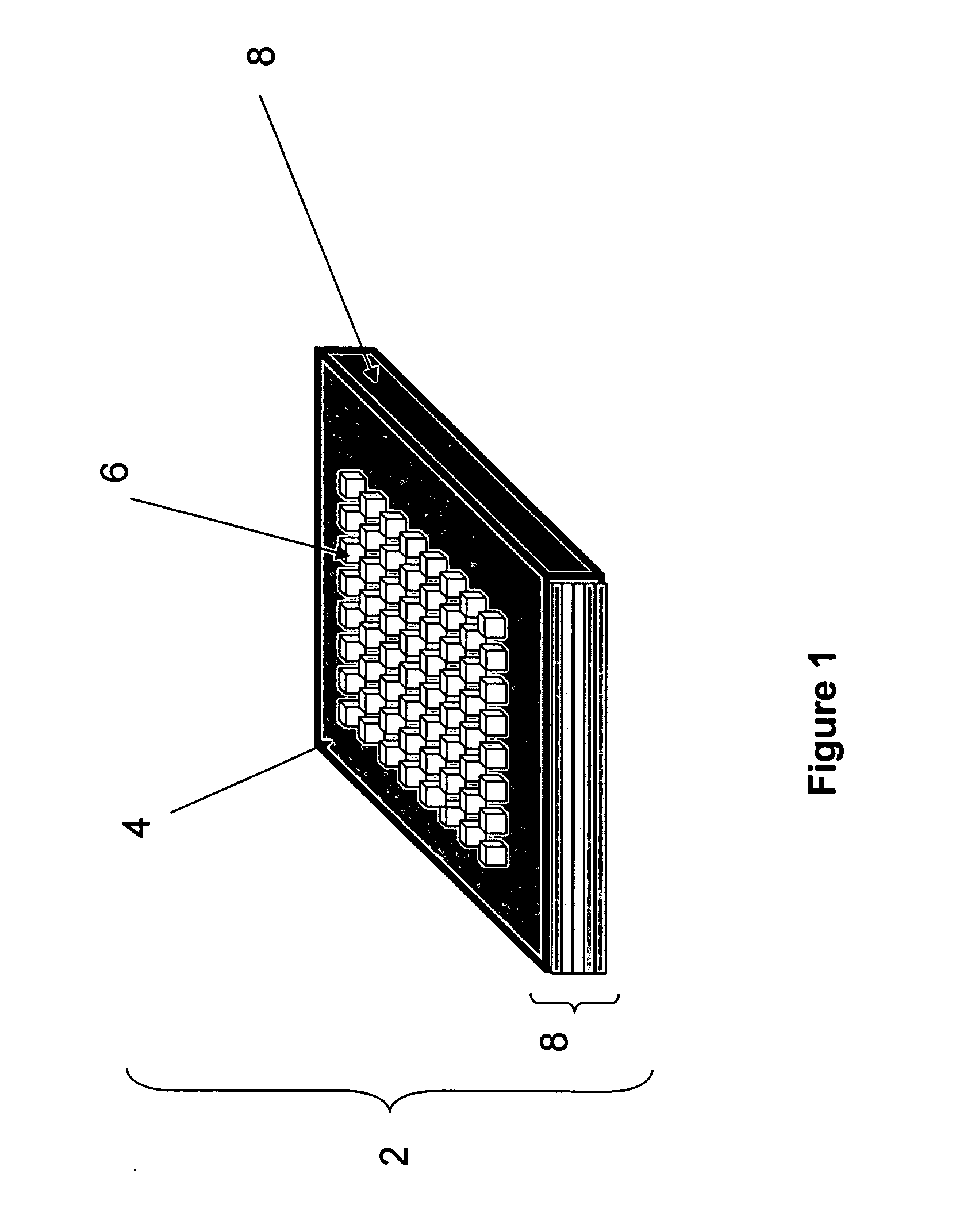Methods and devices for concentration and purification of analytes for chemical analysis including matrix-assisted laser desorption/ionization (MALDI) mass spectrometry (MS)
a mass spectrometry and matrix-assisted laser technology, applied in the field of mass spectrometry, can solve the problems of special problems of mass spectrometry analysis, and loss of analyte peptides, so as to reduce the cost of analysis, increase sample throughput, and convenient use
- Summary
- Abstract
- Description
- Claims
- Application Information
AI Technical Summary
Benefits of technology
Problems solved by technology
Method used
Image
Examples
example 1
Separation of Ubiquitin Polypeptide from Serum Albumin for MALDI-TOF Analysis on a PVDF Thin Film Membrane by using Sodium Dodecyl Sulfate (SDS) to Enhance Polypeptide Mobility
Labeled Protein Standards:
[0111] Texas Red labeled ubiquitin (TR-ubiquitin) and Marina Blue BSA (MB-BSA) were prepared by utilizing the NHS-ester of Texas Red (Cat. No. T-6134, Molecular Probes, Eugene Oreg.) and Marina Blue (product# M-10165; Molecular Probes; Eugene, Oreg.), respectively. The labeling procedure recommended by Molecular Probes was used. Briefly, the NHS-fluorescent labeling species were placed into dimethyl formamide (DMF) at a concentration of about 1 μg / mL and added to a sample of protein at 1 mg / mL, or greater, in standard phosphate-buffered saline (PBS) buffer at neutral pH with vortexing so that the molar coupling ratio of labeling reagent to protein was about 10 / 1. The labeling reaction with the protein sample was allowed to proceed for one hour. The reaction mixture then was passed...
example 2
Separation of Negatively-Charged Serum Peptides from whole Human Serum onto a MALDI-Compatible Membrane
[0124] A major problem with analyzing low abundance peptides in blood, plasma, or serum is that the high abundance proteins mask the appearance of low abundance peptides. Removal of the highly abundant albumin from blood, plasma or serum samples has been reported to also remove a significant number of low abundance peptides. Thus finding a way to dissociate the low abundance peptides from albumin is an important task. In the present studies we treated serum samples with detergents in order to promote dissociation.
Human Serum Samples:
[0125] Detergent-treated serum samples were made by adding 5 mg / mL octyl-β-D-glucopyranoside (OG) to ten (10) μL of human serum (obtained from Sigma Chemical Co.) in an Eppendorf microtube (500 μL volume). The detergent-treated serum was then stored at 4 degrees C. overnight and after 14 hours brought to room temperature. Samples were then made fro...
example 3
Electrophoretic Separation of Positively-Charged Serum Peptides from whole Human Serum for MALDI-TOF Analysis on a PVDF Thin Film Membrane
[0135] Similar to Example 1 and Example 2 above, in this example peptides and small serum proteins from a human serum sample are electrophoretically concentrated onto a capture membrane after having passed through a gel to separate the larger proteins from the smaller proteins and polypeptides of interest. As in the previous examples, the charged peptide and protein molecules drift in an electric field applied by an external anode and cathode. In this example, positively-charged analyte molecules drift toward a negatively-charged cathode and are concentrated and become bound within capture region 68 of a capture membrane 60. The captured positively-charged proteins are then analyzed directly from the capture membrane as described in the previous examples, The MALDI analyses are carried out in a Voyager DE mass spectrometer, as described in Examp...
PUM
| Property | Measurement | Unit |
|---|---|---|
| Concentration | aaaaa | aaaaa |
| Molecular weight | aaaaa | aaaaa |
| Current | aaaaa | aaaaa |
Abstract
Description
Claims
Application Information
 Login to View More
Login to View More - R&D
- Intellectual Property
- Life Sciences
- Materials
- Tech Scout
- Unparalleled Data Quality
- Higher Quality Content
- 60% Fewer Hallucinations
Browse by: Latest US Patents, China's latest patents, Technical Efficacy Thesaurus, Application Domain, Technology Topic, Popular Technical Reports.
© 2025 PatSnap. All rights reserved.Legal|Privacy policy|Modern Slavery Act Transparency Statement|Sitemap|About US| Contact US: help@patsnap.com



